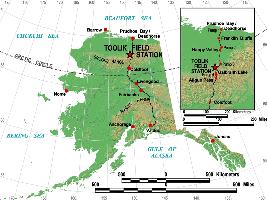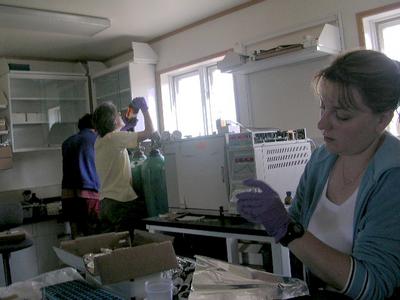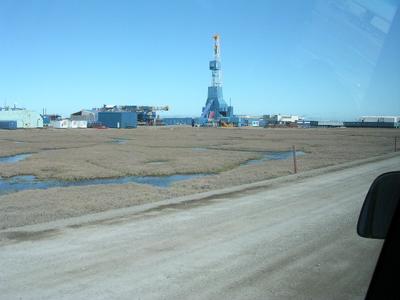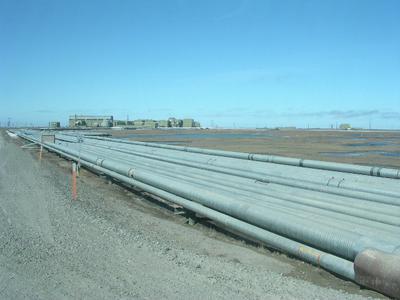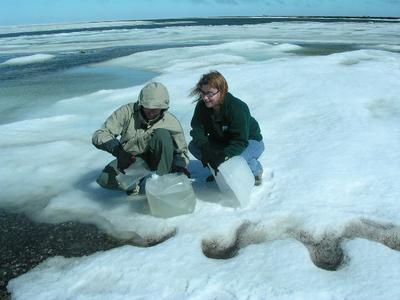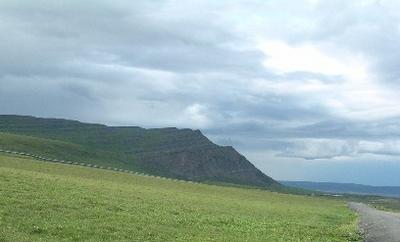
|
15 June, 2004Sampling at the Arctic Ocean This morning, Karen Bejin (another TREC teacher working at Toolik Lake http://www=2Earcus.org/TREC/phpbb/portal_toolik_models.php), Amanda and I took a drove to Prudhoe Bay (about 130 miles or three hours north) to collect water samples from the Arctic Ocean. The road stretching Valdez to Prudhoe Bay is called the Utility Corridor and connects the oil fields in the Arctic Ocean with the ice-free port of Valdez (and therefore the world). Throughout the trip, we paralleled the Trans-Alaskan Pipeline; sometimes it was above ground, sometimes below ground. As you might expect, the drive was extraordinary. Leaving the foothills of the Brooks Range, we drove across the coastal plain of the North Slope of Alaska. The North Slope is home to many kinds of animals: caribou, musk ox, over 20 kinds of birds, grizzly bears, etc. To get to the Arctic Ocean, we could have walked many miles across the tundra to get around the oil fields. But since then we would have had to walk back across the tundra carrying 20 kg (about 45 pounds) of water in bulky containers, we didn't. Instead we signed up for a tour of the oil fields which are hugely interesting, if a bit ugly. Where does the gasoline that runs the cars on our streets come from? Not from Alaska, there's not enough here (not even if they drilled in the Arctic National Wildlife Refuge - National Geographic provides a fairly objective view and useful links: http://magma.nationalgeographic.com/ngm/data/2001/08/01/html/ft_20010801.3.htm. But it could. The technology is fascinating. A couple of highlights: Drilling tower: Can drill almost two miles deep; can be laid sideways and moved (though because it weighs 500 tons, the truck moving it can only move at one mile per hour) New technology allows "lateral drilling", where a single well head and access multiple underground reservoirs of oil. "Flow tubes" carry the water, oil, gas and debris up from the wells and send it to the processing plant Flow tube with harmonic dampener: if you look closely, you can see small chains hanging from the flow tubes. Each chain is a different length, and a large weight hangs from each chain. When these flow pipes were first installed, the howling Arctic winds (sometimes gusting up to 70 miles per hour) made the pipes sing and groan and whistle. Adding weights on the end of different lengths of chains changes the resonance of the pipes, making them vibrate differently, and =91sing=92 less. Of course, we also had to sample water from the Arctic Ocean: (what a onerous chore-not!) We arrived at Deadhorse a couple of hours before we intended (we were warned about road construction and wildlife photo opportunities and traffic jams (oh wait, you need traffic for those) making the trip longer than anticipated). So we took the tour with two couples, one from Minnesota, the other from West Virginia. The couple from West Virginia were (and still are, I guess) the parents of April Cheuvront, teacher, former Arctic researcher, and an especially cool person (TEA 2002 ../tea_cheuvrontfrontpage.html. The drive back was long but equally cool. We drove through downpour, offered to pick up dripping bicyclists (who politely declined the offer a ride), and, though we probably weren't supposed to, it was hard to resist the urge to pose on the spots where the pipeline came up from under the ground. We came back in time for Tuesday's Talking Shop, an informal science seminar in which scientists give others an overview of their work. It's a great time for scientists to learn about the work that others are doing. Biologists studying the plants on the tundra gave a very interesting talk last night. See Laurie Carr's posts on the TREC website (http://www.arcus.org/TREC) for more details! Interesting Fact to Make You Smarter: The Trans-Alaskan Pipeline took only three years to build. It stretches over 700 miles and can deliver about 1 million barrels of oil per day from the North Slope to Valdez (that's a lot of barrels!) The oil is pumped through the pipe with a pressure of 1,180 pounds per square inch. don't get in the way of a leak! Amanda's Limerick Our day had its ups and its downs fieldwork can elicit some frowns But when things work well It feels really swell And gives us an excuse to act like clowns. That's all for now. --
Contact the TEA in the field at . If you cannot connect through your browser, copy the TEA's e-mail address in the "To:" line of your favorite e-mail package. |




